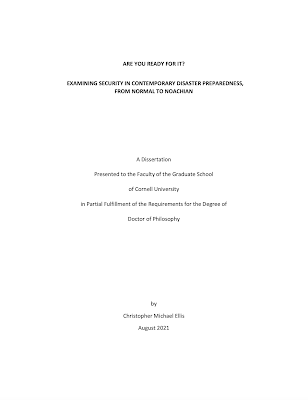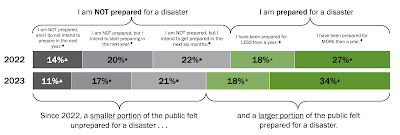This article on Reuters back in March 2024 caught my attention:
Here is a quote about the Survival and Prepper Show which was held in Longmont, Colorado:
"The diversification of prepping was clear last weekend at the Survival & Prepper show at the fairgrounds in Boulder County, a liberal district which President Joe Biden won in 2020 by nearly 57 percentage points over Trump. Over 2,700 people paid $10 each to attend the show, organizers said, and attendees were varied."
Here's why the author believes that there has been a notable increase in the number of American preppers:
"Much of that growth is from minorities and people considered left-of-center politically, whose sense of insecurity was heightened by Donald Trump's 2016 election, the COVID-19 pandemic, more frequent extreme weather and the 2020 racial justice protests following the murder of George Floyd."
Here is a video taken at the show:
Research by Dr. Christopher Ellis, a serving member of the United States military who has a Doctorate from Cornell University and completed his PhD thesis entitled "Are You Ready For It?"
...has thoroughly researched America's prepper community in an attempt to understand the phenomenon and how it has changed over the past few years.
In an article posted on The Prepared, Dr. Ellis provides us with some statistics showing the growth in the preparedness community (aka Resilient Citizens) in the United States. He analyzes data from FEMA's National Household Survey which has been conducted annually since 2013. FEMA's survey measures preparedness of the American public across the entire community. From the 2020 survey, Dr. Ellis found the following:
1.) The number of people who can handle >31 days of self-reliance grew 50% over the 2017-20 period.
2.) The 20 million US preppers mark has solidly been crossed. If you use the broader definition of a prepper as someone who can handle at least two weeks of disruption, the number gets even higher.
3.) That means around 7% of all US households were actively working on self-reliance in ’19-20, solidly increasing from 2% to 3% then 5% in recent years. 10% is only a matter of time.
4.) While the “basic preppers” segment was consistently growing year over year before Covid, the “advanced preppers” segment had been flat or even shrank a little — but that trend reversed in 2020, showing that many people saw the need to go beyond the basics in response to world events.
5.) Rural households are still more likely than urbanites to prep, but we continue to see strong growth among city dwellers.
6.) Perhaps most surprising: the trend in recent years was that preppers were getting younger. But that trend reversed in 2020, with the average age actually increasing a little to 52.6. The number of younger preppers still grew — 25-34 year olds are still the largest segment on The Prepared — but there was even more growth among the older crowd during this period.
If we look at the latest data from the 2023 FEMA National Household Survey (which analyzes data from a survey conducted from February 1, 2023 to March 14, 2023) we find the following:
There has been a significant increase in the percentage of American adults who believe that they are prepared for a disaster since 2017, however, the percentage in 2023 is down from a peak of 59 percent in 2019 just prior to the pandemic which sent shockwaves through the prepper/prepper-adjacent community.
When comparing 2022 to 2023, the survey found that a larger portion of the public felt that they were prepared for a disaster:
The survey found that 57 percent of adult Americans took three or more actions to prepare for a disaster or emergency in the past year:
I found it interesting that 48 percent of Americans either assembled or updated their emergency supplies, up very significantly from 33 percent in 2022.
A demographic analysis of resilient citizens shows that 51 percent have a high school diploma or higher education, 52 percent have an annual income of $25,000 or more and 39 percent are aged 60 or older. Socioeconomically disadvantaged people are also substantial less likely to take higher cost preparedness actions as shown here:
I'm not terribly surprised by the growth in the prepper community over the past decade given the growth in crime and political polarization, a number of severe weather events, the fragility of the electricity grid, the significant growth in inflation and the response to the COVID-19 pandemic which provided us with first hand experience with supply chain issues. While most of us would not consider ourselves to be preppers in the pejorative sense that is often attached to the preparedness community, having a supply of goods necessary to wait out an emergency is simply smart planning. Concrete-lined bunkers are optional.












No comments:
Post a Comment